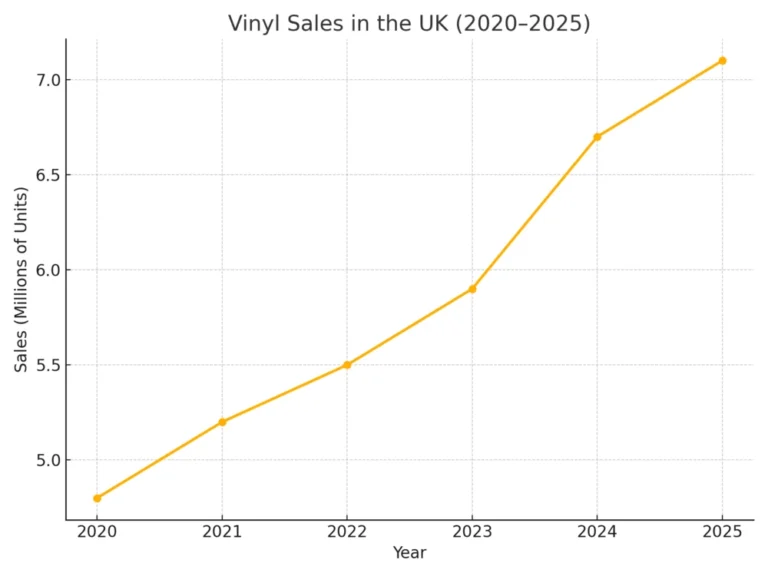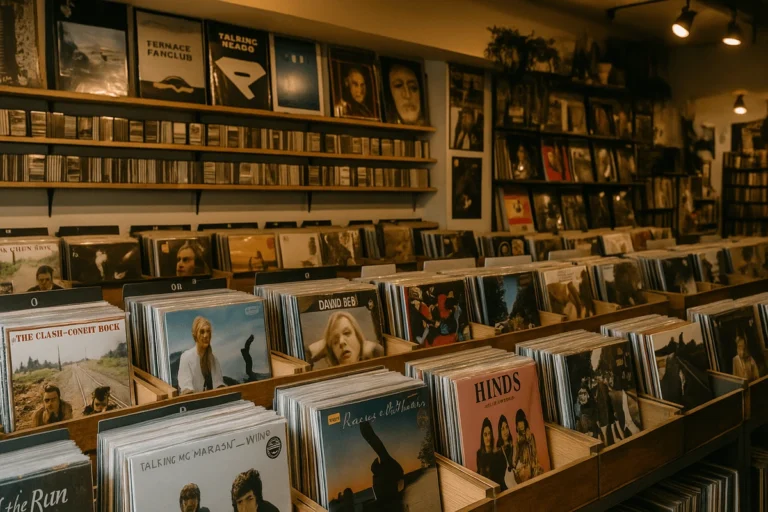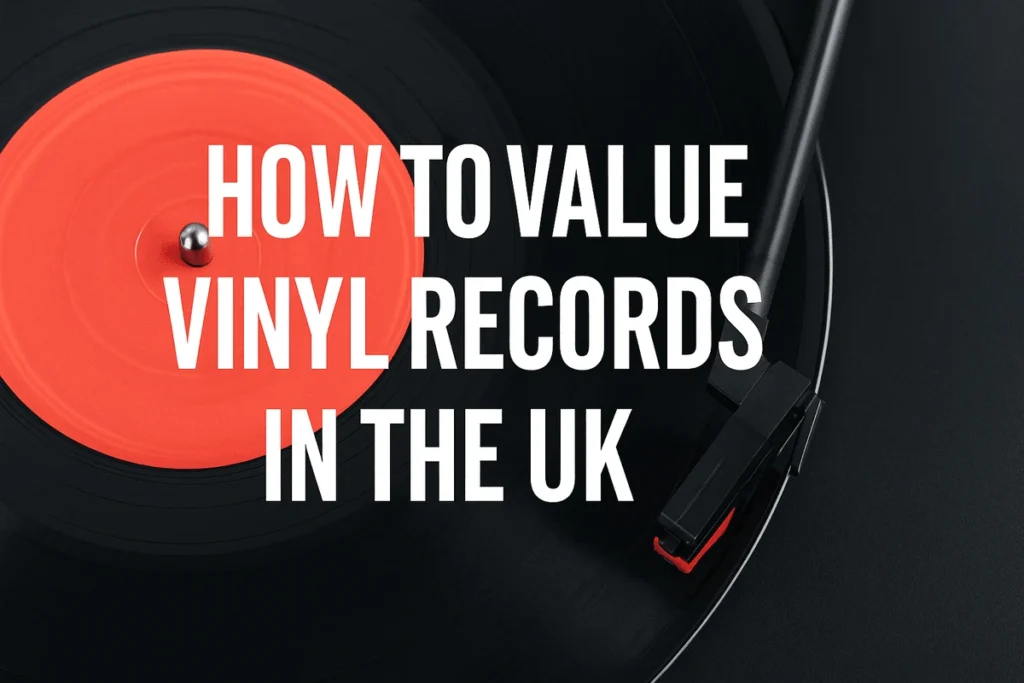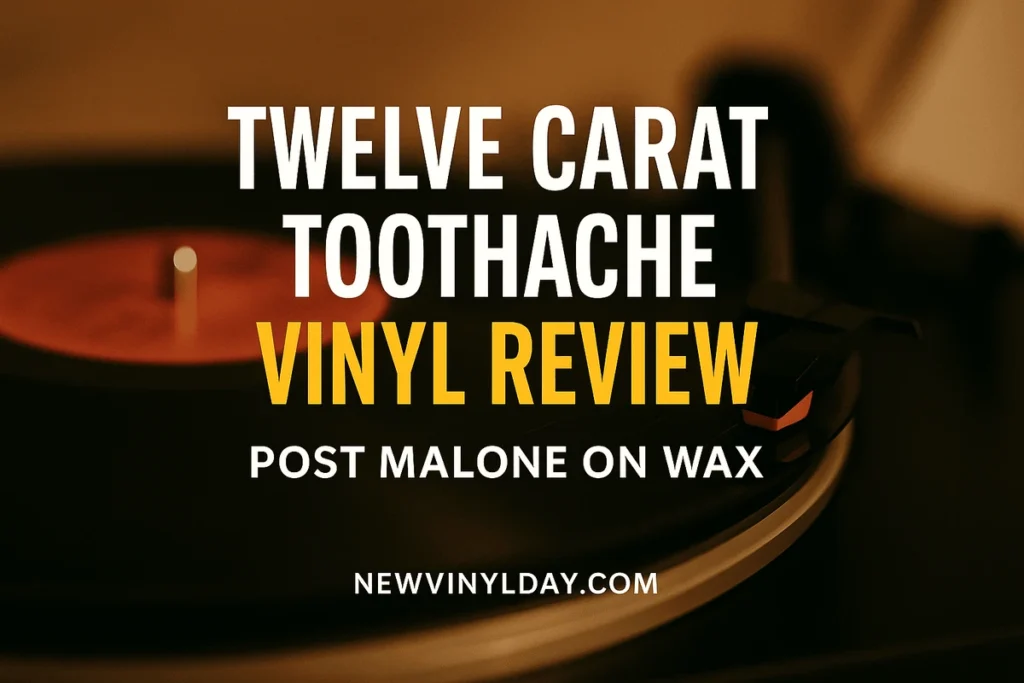UK Vinyl Market: Still Climbing in 2025
The vinyl revival in the UK is still alive and kicking in 2025; sales are breaking post-millennium records, as new audiences engage in listening to (and even collecting) physical music for the first time. After years of slow build, niche commitment, and underground support, records now clearly part of a cultural wave are far more than a patched-up novelty. And the figures for 2025 confirm that growth continues.
According to the British Phonographic Industry (BPI), vinyl sales were again up in 2025, with over 6.7 million LPs sold, a rise of 9.1% over the previous year. Statistically, this is the highest number of LPs sold since 1990! Moreover, increased pre–orders and unit growth in Q1 and Q2 of 2025 have sent strong signals that momentum is continuing; stock sell-offs are happening consistently; and the ever–present demand from both new and old collectors is here to stay.
It does not matter if you are 15 or 50, and if you found a love for music through David or decided to shuffle through once beloved listens, vinyl as a purchasing and listening alternative is for everyone, in all ages, classes and genres, from beginners new to vinyl to those who have collected for years.
UK Record Store Expansion and Signs of the Vinyl Revival
Retailers demonstrate the most obvious indications of vinyl revival in the UK. In the past twelve months, John Lewis partnered with Rough Trade to sell records in-store. WHSmith – yes, that WHSmith reintroduced vinyl into more than eighty of its stores after a 30-year absence from the format. HMV once appeared headed for extinction, but now has over 120 stores and maintains many thriving vinyl sections. This is not just sentimentalism. This is smart business.
The high street’s engagement with vinyl goes beyond simply holding stock of best-selling records. Large displays of vinyl records are often located close to listening posts, curated staff picks, and theme-related genre sections. They invite browsing. Something streaming can’t do. Huge support from the local scene is also provided by independent shops, like Piccadilly Records (Manchester), Drift (Totnes) and Banquet Records (Kingston), who develop their local scene and do events. Record Store Day in April 2025 saw another record turnout, with hundreds of people queuing for limited runs and exclusive drops.
Retailers are betting that physical music, especially records, can provide experiences for people that will make them shop in-store, not just order online. And it is paying off.
Vinyl Revival in the UK: 2025 Sales Stats and Global Comparisons
Let’s talk numbers.
| Metric | Value |
|---|---|
| UK Vinyl Sales (2024) | 6.7 million LPs |
| Year-on-Year Growth | 9.1% |
| Share of Physical Music Sales (UK) | ~50% |
| UK Annual Vinyl Revenue | £130 million+ |
| Global Vinyl Market (2025) | $2.42 billion |
| Expected Global Growth (CAGR) | ~9% through 2032 |
| US Market Note | Vinyl outsold CDs for 3rd year straight |
| Other Strong Markets | Germany, Japan |
But it’s the UK where vinyl’s public profile is most visible: supermarket LP racks, festival pop-ups, TikTok unboxings, it’s all feeding into this culture shift.
What’s Driving the Vinyl Revival in the UK?
A few things are happening at once.
Gen Z and the Search for Physical Music
First, there’s a generational shift. Gen Z listeners raised on Spotify are discovering that owning a physical copy, especially one that sounds good and looks good, offers something more personal. Vinyl offers tactile joy: the weight of the record, the crackle before a track starts, the big artwork. It slows listening down in a world that’s too fast.
Artist Engagement and Creative Releases
Second, artists are feeding the format. Limited colour pressings, signed editions, bonus tracks, and alternate covers are common strategies now. Taylor Swift’s vinyl campaigns have made her the highest-selling vinyl artist in both the US and UK for two years in a row. Sam Fender’s 2025 release People Watching topped the vinyl charts, in part because of exclusive indie store editions and a well-timed tour.
Production Improvements
Third, the pressing industry has caught up, mostly. While delays still happen, there’s more capacity now than five years ago. UK-based plants like The Vinyl Factory and Press On Vinyl (in Middlesbrough) are producing at scale, supporting indie artists and major labels alike.
Collecting as Identity
Finally, collecting is back. Fans want something to own. Whether it’s Fleetwood Mac, Fontaines D.C., or Fred Again, a shelf full of records says something about who you are in a way that playlists can’t.
Vinyl Revival and Streaming: How Social Media Keeps It Spinning
Streaming hasn’t ended vinyl. In many ways, it has enhanced it. Listeners discover music via TikTok, YouTube, or playlists, then purchase the vinyl.
Discovery followed by investment. Social media trends often lead someone to buy their first record player or grab a trending LP. For example, Kate Bush’s Hounds of Love has seen a spike in sales once again this year, thanks to a Stranger Things style viral clip that helped bring her to a new audience. The aesthetic also plays a role.
Instagram reels and unboxing videos have helped make vinyl a lifestyle object. It’s not new but it’s more pronounced. Artists are also responsive and cognizant of the aesthetic factor, producing more beautiful vinyl releases: gatefold sleeves, etching, lyric inserts, interesting colours. These extras don’t get streamed.

Vinyl Pressing Plants and Industry Challenges in the UK
Although demand is high, we haven’t always had the supply to match this demand. There were pressing plant backlogs from 2020–2023, which caused long delays in getting records in the hands of customers, with some albums taking between 9–12 months from mastering to physical delivery. In 2025, things are smoother but not perfect.
In the UK, pressing capacity has improved, but it still lags behind the US. New machines are costly, and labour continues to be a small, qualified group of labour. However, new plants, like Press On Vinyl, and older plants, like the retooled plant at The Vinyl Factory, are making headway to be part of the solution.
Sustainability has come up as a talking point, as some pressing plants now feature some recycled PVC in their production, and some outfits are carbon-offsetting their shipping. While it is not a solved issue, and there is a lot of work to be done to give records their due, there is definitely a discussion about eco-conscious vinyl happening, and that is inherently a good place to start.
Vinyl Revival in UK Culture: Identity, Lifestyle, and Listening Habits
The vinyl revival in the UK is more than sales. It’s about cultural value. LPs are bought not just to listen, but to display, discuss, and share. Collecting records is closer to collecting books or prints. The music is part of it, but so is the object itself.
At gigs, merch tables now sell vinyl before CDs. Artists play entire albums live again. There’s a sense of return to longer-form listening. The single still dominates streaming, but on vinyl, the album lives.
In homes, turntables sit alongside Sonos and smart speakers. People mix old tech with new. It’s not about rejecting digital, it’s about rebalancing it.
Looking Ahead: Will Vinyl Keep Growing?
For more UK vinyl insights and guides, check out New Vinyl Day, your source for turntable culture, vinyl reviews, and record store information.
After 2025, growth may decelerate a little, but that‘s not a collapse. Maturity. Vinyl had a niche associated with it before, now it has infrastructure, retail support and built-in mainstream appeal. The vinyl revival in the UK looks locked in, especially if pressing plants can keep up with demand and artists keep producing aesthetically appealing packages.
Look out for more direct-to-fan releases. Bundling vinyl with concert tickets or merch will keep growing. Crossover between digital campaigns and physical drops is also set to expand. And most importantly, expect vinyl to keep doing what it does best: sitting on shelves, spinning on decks and sounding like something physical.
The Vinyl Revival and UK’s Resale Market Boom
The secondary market for vinyl is booming too. Discogs, eBay, and specialist shops report year-on-year increases in both listings and prices.
First pressings, coloured variants, and exclusive Record Store Day releases are especially hot. Some LPs now flip for five to ten times their retail price within weeks. This demand fuels collector interest but also raises questions about accessibility and affordability.
Major artists are leaning into this economy, releasing intentionally scarce editions that fuel hype and resale value. While not everyone loves the speculative aspect, it does prove that vinyl isn’t just a product, it’s a commodity, a cultural artefact, and, for some, an investment.
Vinyl Revival in UK Education and Archives
More schools and universities are bringing vinyl into music curricula again. Students learn not just how to play and produce music, but how it’s been packaged and consumed over time. Archives like the British Library Sound Archive are digitising rare records while preserving physical copies. Vinyl is being taken seriously as a historical medium.
There’s also a growing niche of youth-led vinyl zines, listening clubs, and student-run radio stations using turntables. It’s not retro, it’s research. And it’s ensuring the next generation values not just the sound of music, but the story of how it was shared.
What Makes Vinyl Irreplaceable?
Vinyl endures in the face of how the way we listen to music has changed fundamentally because, in a world of indistinguishable copies and streamed mediocrity, vinyl is bound to the human experience in ways that can’t be streamed or copied. Here‘s the list of the reasons that people are drawn to it:
- Tactility: You are holding and flipping, lowering a needle.
- Sound quality: Warm, rich tones from physical giant pieces of plastic that digital files can rarely match.
- Artwork: Large sleeves, gatefolds, printed inserts; these are visual stories.
- Collectibility: Each record comes with its own story, colour variants, and matrix codes.
- Connection: There is an act of will in listening on vinyl that defeats distraction.
These aren‘t perks; they are what makes it irreplaceable for so many music listeners.
FAQ: Vinyl Revival in the UK
Q. Why are vinyl sales rising again in the UK?
A. A mix of nostalgia, collectability, artist support, and a desire for real music experiences.
Q. How do vinyl sales compare to streaming?
A. Streaming dominates, but vinyl holds its own, especially in physical format sales.
Q. Is vinyl just a trend?
A. No. It’s now a mature part of the music industry, supported by fans, artists, and retailers.
Q. What are the top-selling UK vinyl albums in 2025?
A. Sam Fender’s People Watching, Taylor Swift’s Lover (Live from Paris), and releases by Chappell Roan, The Last Dinner Party, and Jungle.
Q. Where can I buy vinyl in the UK?
A. Independent record shops, HMV, Rough Trade, John Lewis, WHSmith, and online through Bandcamp or artist
Final Thoughts: Spinning into the Future
This revival has outlived the typical trend curve. It’s no longer just collectors or diehards. Families are buying reissues. Teenagers are diving into back catalogues. Artists are designing LPs as extensions of their vision. From bedroom producers to arena headliners, the format means something again.
Retailers are leaning in. Pressing plants are catching up. More fans are hooked each year. While digital will always be the mainstream path, vinyl now fills a role nothing else can. It’s the format of attention, of care, of presence. It turns listening into an act, not a background task.
The vinyl revival in the UK proves that some things don’t just survive, they thrive when given space to matter. Vinyl has that space now. And it’s not going anywhere.






